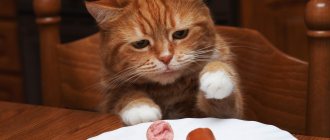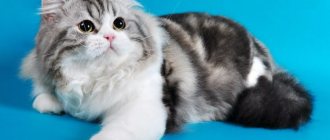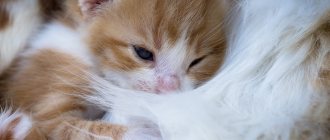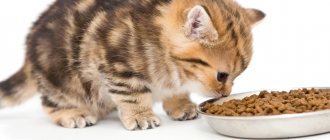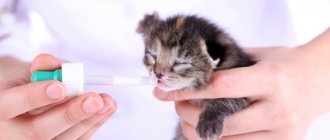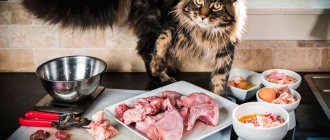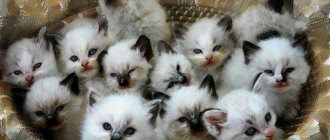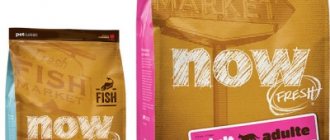All representatives of the Siamese-Oriental group have a fit, graceful figure and a characteristic acromelanic color. They are also known for being picky about food and prone to allergic reactions. It is almost impossible to force a cat to change its eating habits. Therefore, you can feed Siamese cats only with foods that they themselves approve of.
Choosing a place and utensils for feeding a Siamese kitten at home
Asian cats combine two principles - they are playful and active, but secretive and sometimes aggressive. Therefore, in the process of organizing living conditions for a Siamese kitten, it is necessary to take into account the pet’s character traits.
- The place for feeding the kitten should be isolated, but at the same time located within the kitchen.
- If there are other animals in the apartment, you should create conditions under which “competitors” will not disturb the kitten while eating.
- Dishes must meet hygienic and sanitary requirements.
These items are universal for feeding all domestic cats, but the capriciousness of Oriental breeds requires special attention to be paid to food bowls and drinking bowls.
Dishes for kittens and adult cats are made from plastic, metal, glass or ceramics.
- Cheap polymers should be discarded immediately. When exposed to a humid, warm environment, they release harmful substances. Microcracks form on the surface of the dishes, which are difficult to clean. The process of reproduction of pathogenic bacteria begins, which creates health problems in the Siamese kitten. The cost of high-quality plastic cannot be called budget.
- Metal utensils must be coated with an antibacterial coating layer, which prevents chemical reactions upon contact with food. Old stainless steel or aluminum bowls are not suitable for feeding animals.
- Heat-resistant glass and ceramics are excellent materials with a continuous, safe structure. They are practical, easy to clean from food residues, and have good stability.
To properly feed a Siamese cat, you will have to choose a “kitchen set” of a certain size. The dish should be wide, shallow, without recesses in the center of the bottom.
Manufacturers supply pet bowls with a special rubber gasket on the bottom, which prevents slipping on the surface. If we are talking about ordinary saucers, you can glue such a part yourself. You just need to make sure the plate is level and stable.
Another important element in organizing feeding at home is a drinking bowl. It is necessary to provide the kitten with free access to fresh water:
- Siamese cats are attracted to large containers - it is advisable to pour water into large bowls.
- You can place several drinking bowls in the room.
- Some kittens love to drink tap water - you need to give them this opportunity.
It is not recommended to give preference to combined containers, where one part is for food and the other is for water. Kittens are not particularly careful when eating, so pieces of food easily fall into the water and pollute it.
Siamese cat: description
The breed represents a Siamese-oriented group. The appearance of these animals does not exactly resemble an terrestrial animal, but speaks more of an extraterrestrial origin. The head shape of Siamese cats is wedge-shaped, but the ears are huge, like locators. The eyes are somewhat elongated and have a bright blue color.
The cat's body is flexible and refined, and there is complete harmony with the size and shape of the head. The legs are long (comparatively) and powerful, which indicates the excellent physical shape of the animal.
Siamese cat breed description
Watch this video on YouTube
Cat color
After birth, it seems that the kittens are albino, since they do not have a characteristic color, but this is not the case, since after a few days the removed pigmentation of the coat appears. By six months the main color (color point) appears, especially by 10 months.
At the same time, darker shades begin to appear on such parts of the body as the muzzle, ears, paws, and tail. The older the cat becomes, the less noticeable the difference between the general background and the colored parts of the body.
The following shades of spots are considered characteristic of the breed:
- Blue point - blue.
- Lilac point – lilac.
- Seal point is dark brown.
- Chocolate point – chocolate.
- Tetby Point is a brindle-striped breed.
- Red point is red.
- Other.
Breed standards
The Siamese cat is a slender and graceful, as well as flexible and muscular animal, while females are smaller in size and weight.
The neck is long, the head is wedge-shaped, with widely set ears, which especially distinguishes the wedge shape. The muzzle is designed in the form of a mask, which does not extend to the upper part of the head and does not come into contact with the areas of the ears.
The eyes are more like tonsils that are placed obliquely. The iris of the eyes is colored either dark blue or bright blue.
The skeleton is powerful, the muscles are well developed, and the body has a tubular shape. The legs are elongated and the paws are oval. The tail is relatively long and relatively thin, tapering towards the end. The coat is short and lies well to the body. The painted areas of the body are characterized by an even, uniform coloration.
The following are considered to be defects in the breed:
- Presence of white spots and white toes.
- Having an incorrect bite.
- Various colors of the iris, except blue-blue.
- Different number of fingers.
- Uneven or crochet ponytail.
- Exhaustion.
Personality of the Siamese cat
Siamese cats are quite obstinate, but at the same time very good-natured. A cat may dislike one of the family members, and for the rest of its life.
If she loves someone, then this is also for the rest of her life. At the same time, the cat will always demonstrate its devotion and love. Experts believe that this quality of Siamese can be compared with the same quality of dogs.
This breed will not tolerate being forced to do anything and will long remember unfair reproaches in their direction. They do not show aggression towards children, but on the contrary, they can constantly participate in games with them, but only until the cat gets bored. She doesn't like to be carried around, especially by children.
They may be jealous of other pets and may also be wary of strangers.
How many years do Siamese cats live?
Siamese cats, like many other breeds, live on average about 15 years, although there is evidence that some individuals live to more than 20 years, regardless of the presence of certain deviations in genetics.
Siamese Cat Breed Description Character & Care of the Siamese Cat. Veterinary clinic Bio-Vet
Watch this video on YouTube
Natural diet for a Siamese kitten at home
Depending on the type of feeding, the diet of Siamese kittens can consist of natural or industrial products. Each type of menu has its own pros and cons, and in terms of useful properties, both options are considered to be equivalent.
Preparing natural food at home takes time, and the owner has to independently calculate the size and calorie content of portions. But the advantage of this type of feeding provides absolute control over the quality of the feed and the ability to quickly respond to changes in the animal’s body.
What foods should you give your kitten?
Siamese cats eat almost all foods allowed for representatives of other breeds. Approximately 90-95% of the diet is occupied by the main component of the cat's menu - high-calorie protein food.
- meat – lean beef, rabbit, chicken, turkey;
- fish (river or sea).
The average amount of protein is found in cereals and cereals, and the minimum is found in vegetables. But the main supplier of this valuable raw material is still meat (offal) and fish.
- fermented milk group - kefir, yogurt, yogurt, cottage cheese, cheese;
- vegetables, fruits, cereals;
- vitamin and mineral supplements.
Regular dry yeast contains a complex of vitamins that have a beneficial effect on the condition of the coat and skin. They are mixed into the kitten's food or fed separately.
Important! For normal development, a Siamese kitten needs to synthesize 22 amino acids. His body independently produces only 12, and the “building material” for the remaining 10 comes with food.
Rules and regulations for preparing natural food for a Siamese kitten at home
In order not to calculate the daily portion and its composition based on the number of individual useful components, you can create an approximate menu for the week.
- Meat and fish products occupy 90-95% of the daily diet. Half of them come from meat, a quarter from osteochondral tissue (except fish) and 10-15% remains for offal (liver, heart).
- About 1/10 of the weight should be left for vegetables and cereals. In nature, kittens do not eat such foods, but receive them in processed form from the stomachs of small rodents.
- Once a week you need to give your pet one chicken or quail egg (the yolk is recommended) raw or boiled.
In addition, you should pay attention to the animal protein content of the feed. Its norm should be at least 25%, fats occupy 5-20%, carbohydrates up to 10% (although their presence is not considered a prerequisite).
At home, vegetables and cereals are usually mixed with meat ingredients. But if a Siamese kitten eats grated raw carrots, then there is no need to limit him in this.
Contrary to popular belief, milk does not benefit adult cats. Starting from 2-3 months of age, it is replaced with kefir, fermented baked milk, yogurt and other fermented milk products. They are given pure or mixed with fruit.
It is preferable to feed Siamese cats raw meat. First, it is placed in the freezer for 3-5 days, then doused with boiling water and finely chopped or grated on a coarse grater. This product retains all useful microelements, but kills pathogenic bacteria and parasites.
Fish is given no more than 2 times a week. River fish must be boiled, but sea fish can be given raw. Bones are removed from any fish to avoid damaging the gastrointestinal tract.
The serving size depends on the weight of the Siamese cat:
- Products for feeding a Siamese kitten are selected according to the formula: baby weight/10;
- by 4-5 months, the portion size is gradually reduced and brought to the weight/5 equation;
- An adult Siamese cat should receive a daily portion of food of 200-250 g.
Important! At home, complex dishes for a natural diet are prepared according to the general rule - add 2-3 parts of meat, offal or fish to one part of vegetables or cereals.
Ready-made feed
Commercial foods for Siamese cats are divided into two categories: dry kibble and wet mix.
- Manufacturers take into account the age of the animal. Dry food is available in the form of granules of different sizes - for kittens and adult cats. Canned formula for babies is provided in small packages, one package per feeding.
- There is no need to calculate the calorie content of the menu - manufacturers have provided the presence of nutritious and healthy elements.
- A large assortment of food containing various types of meat, fish, and vegetables.
- A series of special industrial feeds are produced, taking into account the developmental characteristics of cats and their susceptibility to certain diseases.
- Feeding a Siamese cat with industrial food at home does not take much time, unlike a natural diet, when the owner has to prepare each portion of food in advance.
Selection of industrial feed
Ready-made food for Siamese cats is divided into several categories:
- Budget economist. The most common group, attractive only by its low cost. This food contains few natural products, a lot of processing of residual meat and bone ingredients, dyes, preservatives and jelly.
- Premium and super premium classes. They differ from each other in the quality of additives and the composition of vitamin and mineral complexes. The main products are of good quality, which puts both offers in the middle price category.
- Holistics are the most expensive food for Siamese cats. Only high-quality raw materials and safe natural preservatives are used here. Another detail is that cereals and grains are completely or partially absent. This is due to the fact that in the natural environment predators do not feed on them and they are not needed as food.
Having chosen a price category, determine the next criterion - type. It is preferable to give kittens wet food, and closer to the age of one year, they can be switched to dry food.
Most often, cats go through three diets throughout their lives. They start feeding the Siamese kitten with natural homemade food or wet industrial mixtures, at puberty they switch to granules, and in old age they combine both methods.
What not to feed
As is the case with other cats, Siamese are forbidden to eat food from the master's table. The following products are strictly prohibited:
- fish or bird bones (including heads, necks, wings) - can injure the animal’s intestines, get stuck in the throat, cause complete or partial intestinal obstruction;
- sweets, confectionery (especially chocolate) - contain components that provoke the development of severe intoxication of the body;
- fatty dairy products and the same types of meat cause indigestion;
- legumes, pasta - cause indigestion and bloating;
- smoked meats (meat, sausages, sausages, etc.) – overload the animal’s liver and irritate the mucous membranes;
- eggplant – causes food poisoning.
Mixed feeding of Siamese cats at home
The mixed type of feeding, which is recommended for older cats, requires special attention from the owner. To maximize the life of an animal, you need to know how to properly combine types of food at home.
- It is recommended to combine industrial feeds from one manufacturer. They implement a general scheme of nutrient balance, and they will not conflict with each other.
- Experts do not advise combining granules and natural homemade food - in such a scenario, control of calories, proteins and vitamins is generally impossible.
- The same goes for the combination of natural food + industrial canned food.
Important! In passive old age, the size of the daily portion should be reduced so that the Siamese cat does not gain excess weight. This leads to additional stress on internal organs, provokes exacerbation of diseases and shortens life.
Feeding with natural products
If you want to feed your Siamese natural products, then you should make sure that they contain the necessary minerals and vitamins. Many people prefer rabbit meat. If the animal is mischievous and refuses such a delicacy, you can try boiling it and offering it chicken or turkey. Few pets will pass by such a tasty treat.
Meat is the basis, but it must be supplemented with cereals and vegetables . The four-legged animals gobble up buckwheat, rice, oatmeal, polenta, and wheat porridge with appetite. And in order for the food to be rich in healthy ingredients, you should add some grated vegetables to it. It could be carrots, zucchini, pumpkin, cauliflower. You should not overdo it with these products, because vegetables greatly clog the smell of porridge and meat, which repels the Siamese.
Important! When preparing food for your cat, you should not add salt or other spices to it. Animals don't need them.
Algorithm for switching a kitten to a different diet
Changing the feeding order from wet to dry or mixed is done gradually. In this case, you need to monitor the kitten’s physical reaction, its behavior and mood.
- When feeding a Siamese kitten from a wet or natural diet to a dry diet, the granules are first lightly soaked in water. This will make it easier for the animal to accept the new food.
- The transition stage lasts from 3 to 10 days, during which time it is necessary to gradually increase the portion of the new product and reduce the old one. During this period (especially after a natural menu), minor stomach upsets may occur.
- During this same period, an additional need for drinking arises - water must always be in the kitten’s field of vision.
- The reverse process follows a similar procedure. When completely switched from granules to natural food, a Siamese cat may refuse to eat at all - industrial mixtures have a strong odor that is not found in conventional products. In this case, 1-2 granules need to be crushed and added to the plate. They will give the food a flavor familiar to the cat.
- Sometimes, between changes in diet, Siamese are given fasting days - after unloading, the pet is less picky.
When switching to any type of food at home, you should consult a veterinarian on vitamin and mineral supplements.
Breed Features
Siamese cats are one of the oldest breeds of the Siamese-Oriental group, which was bred in Siam.
Important! From ancient legends it is known that Siamese cats accompanied the souls of their owners into the afterlife. You could pay with your life for trying to take a Siamese abroad or for causing harm to the animal.
Siamese cats are very jealous. They are the center of attention. Therefore, they do not always get along with other pets (cats, dogs) and do not get along well with children.
Siamese cats cannot tolerate prolonged separation from their owners. Leave the house for a long time, provide your pet with toys so that the cat does not get bored in your absence.
It is believed that Siamese are very picky eaters. In some ways this is true. Siamese are great gourmets and may show interest in foods that cats might not expect. For example, your pet can eat seeds, nuts, mushrooms, and fruits. In general, there are no problems, but still, do not forget that not all the products and treats that we offer to the fluffy are good for his health and, in particular, digestion.
Vitamins and mineral supplements for the Siamese kitten
A Siamese cat cannot extract all the necessary nutrients and trace elements from food. They must be present in food as separate nutritional components.
It is necessary to select a full range of vitamins for a natural diet and add them to the finished dish. Industrial food already contains a number of necessary substances, and the kitten’s owner only has to choose a product taking into account the required complex of vitamins.
Important! An incorrectly selected complex of vitamins and minerals can harm the health of a Siamese cat. Therefore, at home, you can introduce useful additives into your animal’s food only as prescribed by a veterinarian.
What types of British cats are there - all colors in pictures
Many of them have existed since the appearance of the breed, and some were obtained more recently as a result of careful selection.
Solid colors
Chocolate Britons have a nose color that is slightly darker than the coat or matches its color, while Cinnamon, on the contrary, has a pinkish-brown nose that stands out against the darker coat.
Cats of the fawn color (also called the color of a young fawn) have fur of a warm light beige shade, and the pads of their paws and nose are a delicate pinkish color.
Tortoiseshell colors
This can be a combination of rich colors (black, chocolate or cinnamon) with red, as well as blue (or purple) with cream.
The paw pads are pink or black, and the eyes are copper and gold shades. Cream slippers on the paws or short stripes on the nose are possible.
Color point color
A characteristic feature of this group of colors is a light body color and contrasting dark areas - the muzzle, ears, paws and tail.
Tabby colors
Dark stripes stretch along the back all the way to the tail, on the sides there are patterns in the form of curls, the tail and neck are decorated with rings. Colors of this type include marbled on gold and silver, as well as black marbled.
Tiger Tabby (also known as Tabby or "Mackerel") - A longitudinal stripe runs along the line of the spine, from which thin stripes descend on the sides.
Spotted tabby - spots are located on the back and sides, they stand out against a light background. Their shape can be oblong, oval or round.
Sometimes the tail is also spotted or decorated with open rings.
Source
Water in a kitten's diet
A cat's body is 70% liquid, so water is an essential element of the animal's diet. When feeding natural products or ready-made wet mixtures, the Siamese cat receives part of the liquid from food. In this case, she should additionally drink at least 150 ml of water per day.
Dry granules require greater fluid consumption - up to 250-300 ml. The water must be fresh and within the pet’s reach around the clock.
If an animal is somehow able to survive up to a week and a half without food, then the lack of drink will affect its well-being already on the second day, and after another day all life processes will completely stop.
Features of feeding Siamese kittens
The kitten's immunity is developed during the period when it feeds on its mother's milk. Therefore, the main task of the first complementary feeding is to take over the baton from the nursing mother and continue the formation of a strong organism.
- up to 3 months, kittens eat 6 times a day - serving size is 100-150 g, depending on the appetite and size of the baby;
- up to six months, Siamese cats eat 4-5 times a day, and the amount of food is increased to 200-250 g;
- then, up to 10-12 months, the grown-up Siamese makes 3 approaches to the bowl - the daily norm is 300-350 g.
At the age of 1 year, the kitten’s diet changes - twice a day (natural products) or dry food, which is constantly on the plate. A standard daily portion of “natural” weighs about 0.4 kg.
When using industrial dry granules or canned food, the serving volume is calculated taking into account the weight and age of the animal. Usually the manufacturer indicates all the necessary information on the food packaging.
Choosing a kitten class
The division of cats into classes was invented by breeders in order to better understand their physiological quality in the future. This classification is informal. Kittens are placed into classes immediately after birth. Babies from the same litter can belong to different classes, and subsequently the class of each of them can also change. There are 3 classes - show, breed and pet.
Show class animals are the best representatives of cats, they fully comply with all the characteristics of the breed and have excellent exhibition prospects. These kittens are the standard of the breed. They can be sold in co-ownership or with certain conditions; finding them is a great success. The price of such an animal will be the highest of all classes.
The main purpose of the breeding class is childbearing and breeding. They are great for breeding. Cats in this class have good pedigree and reproductive traits. With the right approach to care and breeding, breed-class animals can produce show-class kittens. Breed class cats can also participate in exhibitions and receive titles, but this happens less often. They are not much cheaper than show class cats, but among them you can find a show class kitten in which all its advantages have simply not been considered.
Pet class kittens are not of exhibition or breeding interest to the breeder. They may have some defects that distinguish them from breed standards, but do not affect the health of the animal. Such cats are usually bought for the soul. These are affectionate pets that match the character of the breed. Kittens are sold only if sterilized. This is also indicated in the documents.
Feeding an older cat
As they age, all pets begin to develop health problems. They can be expressed in kidney ailments traditional for cats, thickening of the heart muscle wall (cardiomyopathy), deterioration of vision, hearing, and musculoskeletal functions.
For all standard diagnoses of older cats, manufacturers of industrial mixtures have ready-made food solutions, where the food contains sets of supporting additives, vitamins and microelements necessary for the health of Siamese.
With the onset of the passive period, when the cat is not active, the portion size decreases. The owner needs to carefully monitor the pet’s weight, not to allow it to increase and create excessive stress on the internal organs.
In old age, you should not do fasting days, you just need to reduce the calorie content of food and its quantity.
Important! For older cats who are prone to overeating, it is not recommended to leave food out for the day. Even in the case of feeding dry mixtures, the animal is given a certain time to eat, and then the plate is removed. But water must be freely available around the clock.
What should you not give?
When choosing products to feed Siamese cats, you need to be as demanding as possible.
Siamese are prone to various diseases, most of which are the result of improper feeding.
- It is strictly not recommended to overfeed your cat with fish, since over time the animal develops an allergy, causing swelling on the face in the area of the eyebrows and under the jaw. This can lead to difficulty breathing and a general deterioration in the animal’s condition. If this happens, be sure to give the animal a sorbent and an antihistamine, and then immediately contact a veterinarian.
- The same advice applies to any citrus fruit. For example, you should not offer your animal meat with orange sauce from your table. Your pet will definitely beg for it, but show restraint and don’t give it.

